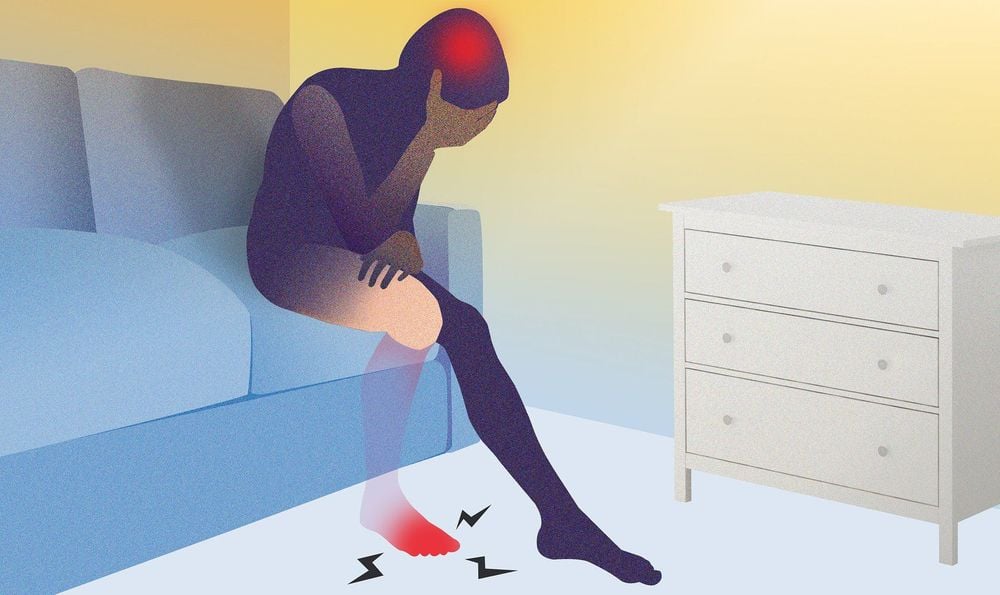This is an automatically translated article.
The article was written by Doctor Bui Hanh Tam - Department of Anesthesiology and Anesthesia, Vinmec Times City International HospitalPeople with an amputation of an arm or leg face many challenges in daily life, including suffering from phantom pain, or phantom pain, if left untreated.
1. Why is there phantom pain?
This is a common sensation that occurs in the arms and legs where they feel pain in areas of the body that have ceased to exist. The pain can range from a mild ache, as if the limb has fallen asleep, to an uncomfortable burning and throbbing sensation. Especially the wounded soldiers after the war, although the amount of morphine used was very high, they still had to endure pain day and night.“Ghost sensation” is a new and unusual sensation that occurs in a part of the body. It is not the same as feeling pain. Most people have this feeling that goes away after a few days to a few weeks.
“Ghost pain” or phantom pain is a persistent pain after the body tissue has healed and is characterized by pain and sensory disturbances, described by terms such as: Burning, cramping, pounding, sharp pain, twisting, and feeling the limb is in an unusual position. This pain is sometimes constant, sometimes intermittent.

Đau chi ma đặc trưng bởi triệu chứng đau và rối loạn cảm giác
Perception of a lost limb is not the norm for a previously healthy human body. The brain is almost in a mess because it doesn't receive signals from the lost body part, and the brain's basic response to that "loss" causes phantom pain.
Today, with further research with the help of imaging tools, functional changes by brain magnetic resonance have been studied, namely, there is a change in the shape of the brain. The image is very clear in the part of the brain that governs the sensations corresponding to the amputated legs and arms and the phantom pain resulting from that change.
So phantom pain is really a disease and needs support and treatment.
2. When does phantom limb pain occur?
People who have had their limbs amputated due to trauma, accidents, or malignancies will be at risk of a dull pain that lasts for many years. The brains of these people send signals through the nerves to the pain site, which in fact no longer exists, causing pain similar to that of injury when the limb has not been amputated.This pain affects the quality of life, even a lot of people have depression.
2.1. Pain before amputation There have been a few studies conducted that have looked at why phantom pain is common in patients with pre-amputation limb pain. Research believes that the brain will keep a special memory of pain if the period of the leg or arm is injured or touched, but it is not handled, especially if the pain is not well relieved. The brain will continue to send pain signals throughout the body with or without the limb actually there. This stage usually occurs around the time of acute injury to the legs and arms.
2.2. Usually, coccyx pain occurs if there is nerve damage from the incision and these nerves continue to grow abnormally. Nerve cells (injured nerve endings) will form neuromas in the stumps and this pain will increase in intensity and duration of pain if not treated promptly. . Later on, the pain of the stump will continuously dull day and night and often hurt more at night.
2.3. Non-standard prosthetics Finding a prosthetic that fits the body can be a challenge requiring patience and experimentation - replacing as needed. Prosthetics are a very important part of recovery from amputation, not only physically, but emotionally as well. An ill-fitting prosthetic can leave the patient feeling pinched, aching, and irritation that can slowly progress to phantom pain.
3. How can pain relief at home?
Mirror Therapy aims to eliminate symptoms of chronic pain caused by phantom limb by means of illusion.Using a flat mirror to self-hypnotize with images with the principle of changing brain perception by exploiting illusions to reduce pain for the patient in order to trick the patient's brain so that the brain perceives that the person the disease is observing the part of the body (arms, legs) that is no longer there. Then the patient's brain will think that the lost body part is still there and the pain will be reduced.
The injured hand or foot is in the mirror box. An intact hand or leg is parallel to the mirror, creating an illusion that the amputated arm or leg is still intact. Imagine and practice the movements of moving, relaxing, holding in the same direction and with the same time created by the good hand and leg.
This mirror therapy is easy to do soon after a leg amputation; Manual, inexpensive, daily do-it-yourself help reduce pain medication, as well as medication side effects, and improve quality of life.
This test makes sense to apply in a country that has gone through two devastating wars like Vietnam, a country with a very high rate of traffic accidents and currently the rate of cancer is increasing every day, Therefore, the amputation rate of legs and arms is very high to limit metastasis from bones and tissues to other organs.
4. What to do to limit the risk of phantom limb pain?

Áp dụng các biện pháp kiểm soát đau ngay từ giai đoạn sớm giúp ngăn chặn giảm đau sau mổ
At Vinmec hospital, regional selective anesthetic techniques are performed in almost all types of surgery, especially those related to leg and hand injuries due to trauma, plastic surgery, cancer surgery. ...
Pain that is not well controlled before surgery, amputation of the upper limb, amputation of both sides, amputation in women and anxiety and depression during the injury process are high risks leading to pain ghost. Therefore, the patient will have the earliest and most effective pain control right before surgery, and a solution will be found to block pain signals before it is transmitted to the specific brain by anesthetic techniques. Nerves supplying the hands and feet are injured such as:
Selective anesthetic techniques for the great nerve trunks: the sitting nerve, the femoral nerve, the peroneal nerve, the tibial nerve, the radial nerve, the ulnar nerve, median nerve.... Techniques to numb the nerve plexus: brachial plexus, lumbar plexus.... All of these techniques are performed by pain physicians. has many years of experience under the guidance of neuro-ultrasound machines, nerve stimulators... are the most modern devices being used in the world today.
On the other hand, with this technique, it is possible to do many times during the course of multimodal treatment in the acute pain stage around the surgery. In addition, a multimodal pain management strategy implemented in a timely and planned manner will help reduce this risk postoperatively.
5. What to do to treat phantom limb pain?
Once diagnosed with phantom limb pain, the patient's life will be very miserable with torture and pain day and night. Patients can self-administer mirror therapy at home with phantom limb pain caused by amputation of a leg or arm. However, phantom limb pain is a type of pain caused by the loss of any part of the body (be it teeth, breasts, penis, toes, fingers, vascular system...).Up to 70% of patients suffer from phantom limb pain after amputation and up to 50% of them suffer from this pain for 5 to 7 years afterwards.
With a team of doctors who are always updated with the latest, most effective methods that have been proven effective and have been applied in many advanced countries in the world such as the US, France, Japan, Korea...will helping patients with phantom limb pain have the opportunity to partially reduce their pain and improve their quality of life when coming to Vinmec hospital.
Please dial HOTLINE for more information or register for an appointment HERE. Download MyVinmec app to make appointments faster and to manage your bookings easily.













